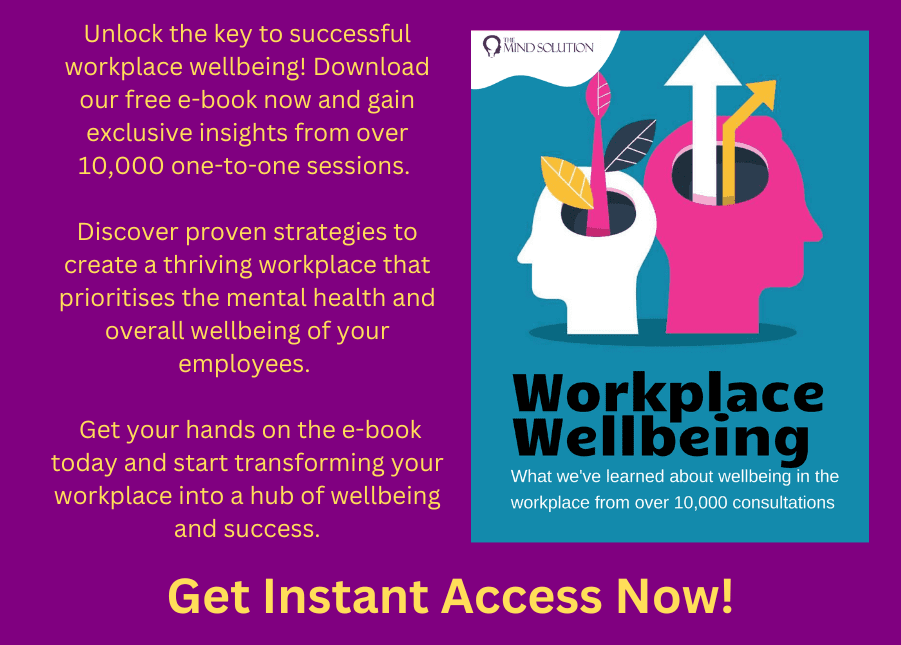“Good health IS good business.”
– Paul Drechsler, Chairman/CEO, Wates Group Limited
Developing a workplace wellbeing strategy that resonates with your company’s vision and yields tangible outcomes is not just beneficial, it’s strategic. Yet, embarking on this journey, particularly if wellbeing isn’t your forte, can seem daunting.
Reflecting on my decade-plus HR journey, I relate to the challenge. In various roles, including a stint in the NHS, my mandate was clear: cut down on absenteeism. The traditional methods – referrals to Occupational Health, absence management workshops, and enforcing return-to-work interviews – felt like hitting a wall. The stats barely budged.
Everything changed when I delved into Solution Focused Psychotherapy and Hypnotherapy. I wasn’t just attending another stress management seminar; this was an immersive weekend unravelling the neuroscience of stress, light years ahead of any corporate training.
In that enlightening weekend, I had several epiphanies. Firstly, my entire HR career had been under the shadow of unrecognised stress, manifesting in physical ailments I hadn’t connected to until then. The second revelation was even more striking: work-related stress, as a standalone concept, didn’t truly exist. Countless G.P. sick notes had hinted otherwise, but the reality was stark – stress stems not from our jobs or surroundings but from our internal responses and resilience.
The third realization? This knowledge was too vital to remain confined. It dawned on me that bringing this insight back into the corporate arena, where I had navigated for years, was imperative.
Employee wellbeing, once a token gym membership or the untouched basket of free fruit, has now transcended to a broader, more nuanced domain. And it’s in this expansive field that many, even seasoned HR professionals, find themselves at a crossroads, wrestling with the enormity of shaping an employee wellbeing strategy without a clear roadmap.
Drawing from my extensive experience in personal coaching and understanding of effective wellbeing practices, I stand ready to guide those embarking on this vital journey, ensuring your strategy not only exists but thrives and transforms your workplace.
Creating an Employee Wellbeing Strategy

Why is formulating an employee wellbeing strategy crucial? The answer is straightforward: it’s about shifting from a haphazard approach—akin to tossing jelly at a wall and hoping for it to stick—to a methodical, impactful methodology. It’s astonishing how many major corporations lack a structured employee wellbeing program. Often, the approach is reactionary: a sudden push for wellbeing sparks a flurry of ad hoc requests for webinars or mental health training.
Yet, when probed further about:
- The rationale behind choosing specific topics
- Success metrics for these initiatives
- Alignment with broader HR or wellbeing strategies
- Desired takeaways from the sessions
- Methods for gauging the training’s effectiveness
I’m frequently greeted with puzzled looks.
The genesis of an effective employee wellbeing strategy is straightforward: start by pinpointing your objectives. Engage with your team to envision your organization and its staff a year ahead. What transformations do you aspire to witness?
Crafting this vision doesn’t require you to be a wellbeing maestro. It’s akin to any strategic planning, be it in HR, Marketing, or Sales: you begin with the end goal in sight.
Without a clear endpoint, you risk deploying a series of hit-or-miss tactics. So, step back, strategise, and set a clear, actionable path towards fostering a thriving, well-supported workforce.
Using HR Data and Metrics to create your wellbeing strategy
Before diving into the specifics of your employee wellbeing strategy, I urge you to first consider the insights you already possess. Ask yourself: What’s functioning well, and what areas are lacking?
Reflecting on my time as an HR Business Partner at Virgin Atlantic, I oversaw the contact centre and brought a keen interest in this sector, fueled by my academic research on motivation and retention in call centres. A thorough data review revealed an annual expenditure of £400,000 on sickness absence in a 300-person contact centre – a staggering figure by any measure.
Armed with a deeper understanding of mental health and stress, I recognised the potential to reduce this cost by at least 10%, translating to a substantial saving of £40,000 for the company.
I share this anecdote to highlight the importance of leveraging existing data to sharpen your focus. A comprehensive employee wellbeing strategy doesn’t need to be extravagantly detailed, encompassing every facet of mental health and wellbeing.
Begin with a straightforward goal, secure consensus on this vision, ensure it’s a collective aspiration, and then delineate the steps necessary to transform this vision into reality. For more insights on how to effectively utilise your data, consider the additional tips provided in the video below.
A meticulously crafted employee wellbeing strategy can yield remarkable benefits, leading to a more contented, healthier workforce and a significantly improved financial standing. Take Oracle’s initiative as a compelling case in point: in 2014, by introducing resilience training, the company managed to cut over £1 million in costs related to sickness absence—a testament to the strategy’s efficacy.
It’s crucial to note, as this blog emphasises the impact on sickness absence, that an employee wellbeing strategy encompasses far more than merely diminishing absence and illness rates. Wellbeing is multifaceted, a notion vividly illustrated in the image presented below, highlighting its diverse dimensions and far-reaching implications.

The Value of Having an Employee Wellbeing Strategy
The value of having a workplace wellbeing strategy is substantial and can be measured through various indicators. By implementing a strategy that works for your organisation, these can be some of the returns you can expect to see the following benefits:
- Reduced absence and cost of absence: An employee wellbeing strategy can lead to a decrease in employee absenteeism and the associated financial burden it poses on the organisation.
- Decreased long-term sick leave: A focus on employee wellbeing can help reduce the number of employees on long-term sick leave and the duration of their absence, contributing to improved productivity.
- Increased employee retention: When employees feel supported and valued through wellbeing initiatives, they are more likely to remain with the organisation, reducing turnover costs.
- Fewer health claims on private medical cover: By promoting preventive measures and fostering a culture of workplace wellbeing, you can expect a decrease in health claims and associated costs.
- Reduced presenteeism: Presenteeism, where employees are physically present but not fully engaged or productive, can be mitigated through workplace wellbeing initiatives, resulting in increased efficiency and output.
Additionally, a workplace wellbeing strategy can also yield the following benefits:
- Increased engagement levels: Workplace wellbeing initiatives contribute to higher levels of employee engagement, leading to a more motivated and committed workforce.
- Improved customer and client feedback and scores: When employees are well-supported and fulfilled, it positively impacts their interactions with customers and clients, resulting in improved feedback and satisfaction ratings.
- Consistent high-performing individuals and teams: A focus on employee wellbeing can help individuals and teams thrive, resulting in sustained high performance and achievement of organisational goals.
- Enhanced creativity and innovation: Employees who are physically and mentally well are more likely to think creatively, generate innovative ideas, and contribute to the organisation’s growth and development.
- Increased feeling of inclusion and psychological safety: Workplace wellbeing initiatives foster a sense of belonging, inclusivity, and psychological safety, creating a supportive work environment where individuals can thrive.
- Reduction in accidents and health and safety issues: By promoting physical and mental wellbeing, organisations can experience a decrease in accidents, injuries, and health and safety issues.
- Reduction in customer complaints: Well-supported employees who are thriving in their work are more likely to provide exceptional customer service, leading to a decrease in customer complaints.
- Increase in sales and profit: A workforce that is physically and mentally well is more likely to perform at its best, resulting in increased sales and overall profitability for the organisation.
- Recognition and awards: Organisations with a strong commitment to employee wellbeing often receive recognition and accolades, positioning them as leaders in the industry and an employer of choice.
Implementing an employee wellbeing strategy is, unequivocally, a wise decision! Once your vision is crystal clear, along with well-defined goals and objectives, that’s the opportune moment to engage a seasoned professional. They can meticulously outline the implementation process and pinpoint the most impactful approach.
Perceive your employee wellbeing strategy not as a static plan, but as a dynamic, ever-evolving framework. Diligently monitoring its impact and assessing the return on investment allows you to pinpoint triumphs and identify sectors needing enhancement or additional resources. This practice fosters perpetual refinement, ensuring your strategy continually aligns with the changing needs of your workforce and organisation.
Don’t hesitate to reach out today to explore how we can assist you in crafting an employee wellbeing strategy that’s tailor-made for your workplace’s unique requirements.

Sara Maude, a seasoned Solution Focused Psychotherapist, Transformational Coach, Hypnotherapist, and EFT Practitioner, brings over a decade of mental health expertise to global organisations. She specialises in workplace wellbeing training, employee health and wellbeing programs and mental health training for managers. Sara’s proficiency also extends to wellbeing consultancy and wellbeing strategy, contributing significantly to the enhancement of employee wellbeing in the workplace.
